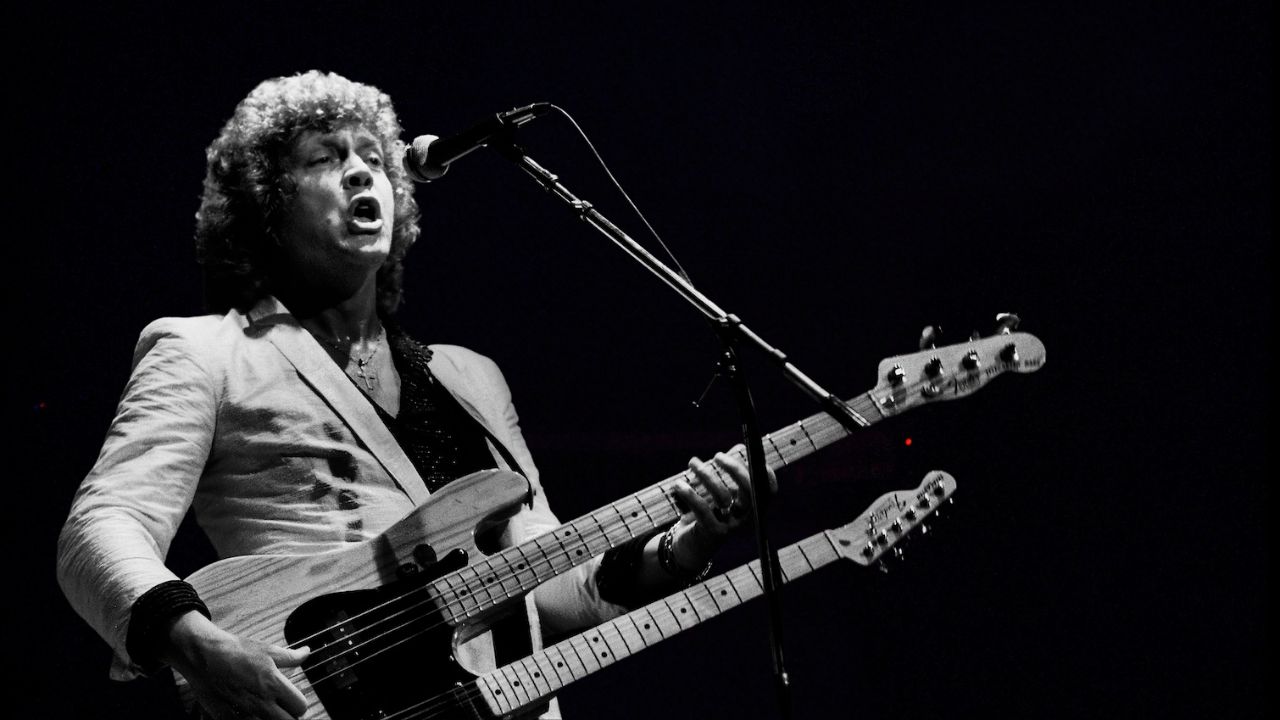Guitar World Verdict
Guitar World verdict: Everything a sequel should be. Inspiring effects you won't want to play without, easy to use in every respect and deep preamp controls for live players.
Pros
- +
Great selection of effects that will enhance your playing experience
- +
Excellent app to offer deeper but intuitive control.
- +
The new EQ and tone-shaping tools make this an effective stage preamp.
- +
You can fit it to most electro-acoustic guitars.
Cons
- -
You will need to explain to your friends and family why you're spending even more time playing with your acoustic!
You can trust Guitar World
What is it?
Guitar gear is a such a strange case of extremes – many of us are still (rightly) in awe of instruments that surfaced in the '50s – even before in the case of acoustic guitars – and are quite happy for them to remain largely unchanged in design, but when it comes to the world of digital processing, the expectation is usually rapid evolution. But there are exceptions.
The ToneWoodAmp is still out on its own, even though the likes of Lava Music and Yamaha have developed similar technology that allows effects to be generated through the body of an acoustic guitar without a traditional amp or pedal in sight.
Because while the competition is built into bespoke electro-acoustic guitars, ToneWoodAmp founders Ofer and Helene Webman's device can fit on any electro-acoustic, via a jack cable and X-Brace magnetic platform placed fixed inside the guitar by the user – and without any permanent changes to it required.
Using the patented technology of its predecessor, the ToneWoodAmp2 creates vibrations and when it is fixed to the back of your guitar it's these that create effects without the need for a traditional speaker. The effects are combined with your guitar's usual acoustic response and the result is very impressive indeed.
Acoustic guitarists often get left out of the heady world of effects – making do where they can. Now the proposition was a wonder box that unlocked new inspiration for players anywhere they took their guitar, but also something that could be used live through a line-out. It was the kind of thing that could impress your friends but prove itself as a worthwhile investment in the longer term as a musical tool.
But could it be better?
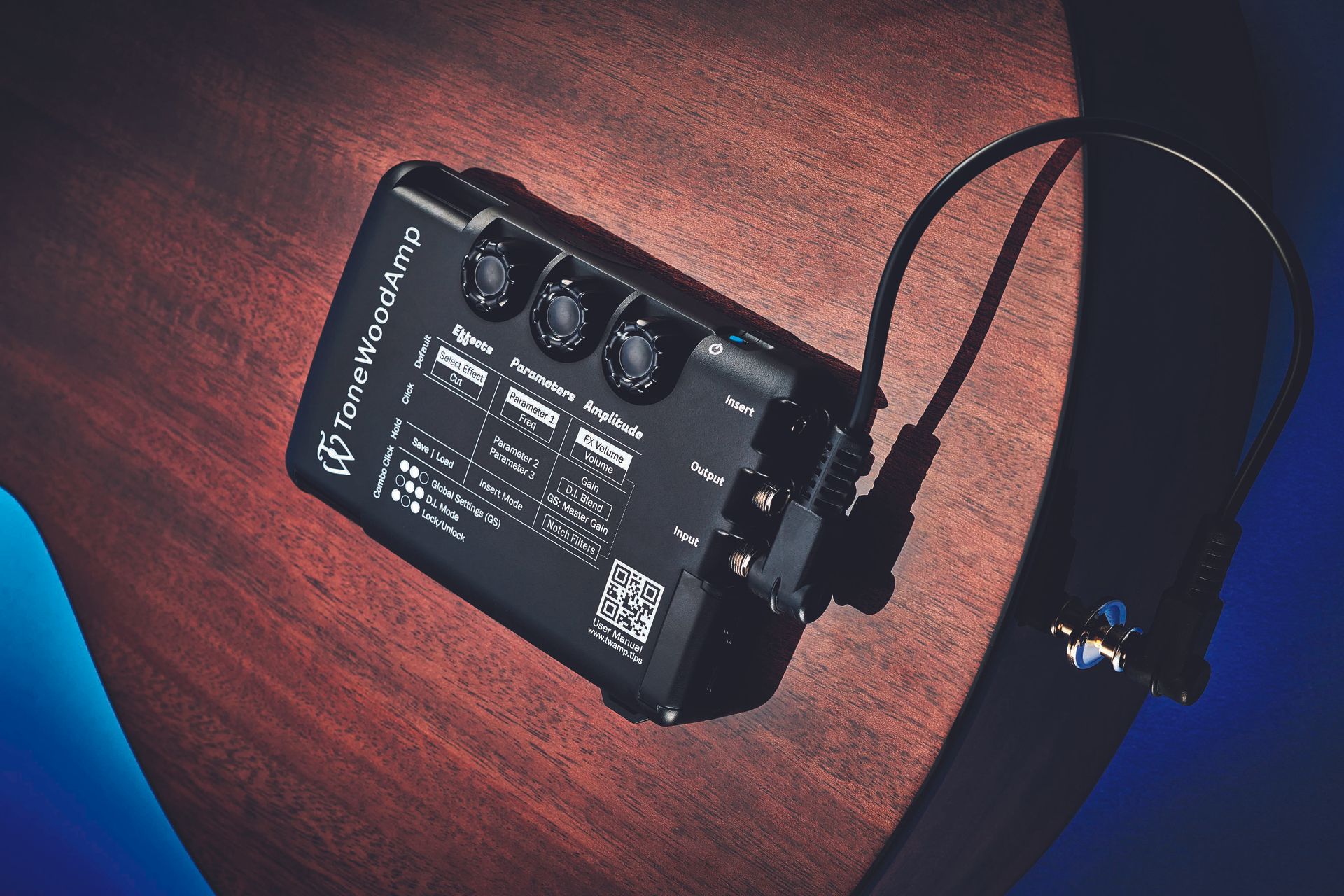
As good as it was – Guitar World called it "truly Revolutionary and I hailed it as a "fantastic creative tool" when I reviewed the original for MusicRadar – there's always room for improvement in the next step. And for designer Ofer, he had a decade of player feedback to combine with his own instincts for evolution. And all that doesn't just mean a lot of new features for the ToneWoodAmp2, but also fundamental enhancements that new and existing users might appreciate.
All the latest guitar news, interviews, lessons, reviews, deals and more, direct to your inbox!
"There were a few main priorities," Ofer tells me in a video call alongside wife Helene from their home in Arizona. "One was the size – we wanted to reduce the size a little and we wanted to improve on the compatibility of the device with curved back guitars. So we created a mechanism that allows you to change the angle of the ToneWoodAmp with the back of your guitar. We call it the Lift Kit.
"The other one was the rechargeable battery," adds Ofer. And this may seem obvious but it's going to be a big one for owners of the previous model because that used three AA batteries. Battery life is now increased to over ten hours from around 5-6.
We see it today as a two-in-one device, and not only an off-stage device
Ofer Webman, designer
But there are other fundamental ways ToneWoodAmp2 can potentially offer more to players; there's now Bluetooth connectivity and an app. Quelle surprise, some may say – apps being partnered with hardware isn't a new thing these days. But in the context of the "better functionality onstage" Ofer wanted to deliver for those players who were using the ToneWoodAmp as an integral part of their live rig, it could be the missing link. If it works well - never a given with Bluetooth, in my experience.
Ofer is keen to point out that the live user was a priority in the design process this time – where it could be argued it was more of a 'nice to have' approach before. The app reveals that the ToneWoodAmp2 has serious EQ-shaping power under the hood now.
"In a way, we see it today as a two-in-one device, and not only an off-stage device," Ofer explains. "We always marketed the ToneWoodAmp as an off-stage device, but we believe that [ToneWoodAmp2] is a great off-stage device but a really good onstage device too.
"If you want something that is a very small footprint preamp, to be able to go on stage and have your effects and have all the other tools that help your guitar sound good, it's a pretty good solution to take from the bedroom or the living room and go on stage without carrying a stack of pedals.
"It's not only about the effects, though," he emphasises. "It's also about the tone shaping." As I discover, this is not an understatement.
Specs
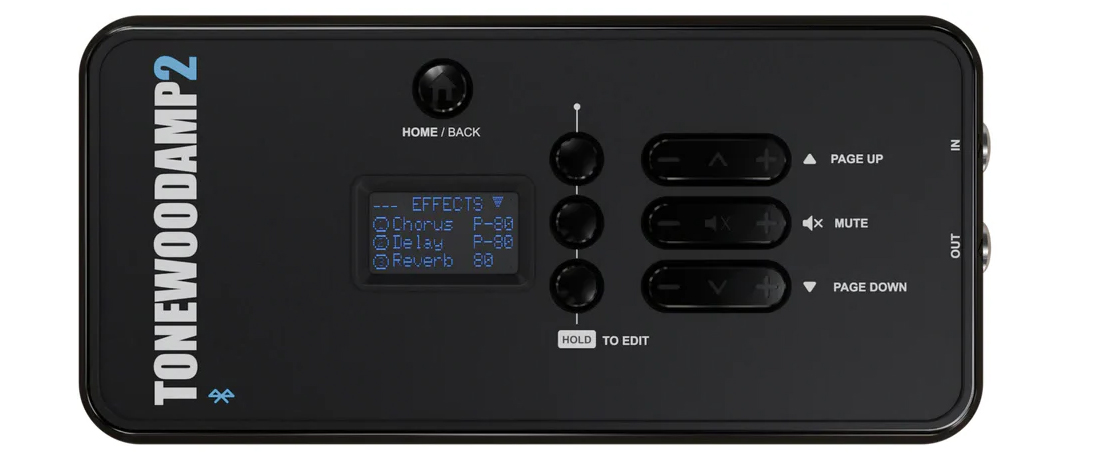
- Launch price: $310/£299
- Type: Portable effects generator and preamp for electro-acoustic guitars
- Controls: Delay, Reverb, chorus on/off and level up and down, Mute, Page Up and Page Down
- Features: Delay (including five subdivisions), Reverb (Hall, Plate and Room), Modulation (Chorus, Phaser, Flanger, Vibrato), Tremolo (Sine and Wave) with four simultaneous effects and parallel/serial routing, three-band EQ, compression, boost, wet-dry mixer, notch filters, phase inversion, adjustable gain, onboard presets, companion app for iOS and Android, integrated LiftKit for fitting to curved back acoustics, left-handed mode.
- Connectivity: 1/4-inch jack in and out, Bluetooth for app connection, USB-C for battery charging.
- Power: USB-C rechargeable (10 hours+ life)
- Dimensions: L x W x D 149mm x 70mm x 26.5mm
- Weight: 284 grams
- Contact: tonewoodamp.com
Guitar World demo with Mike Dawes
Build quality
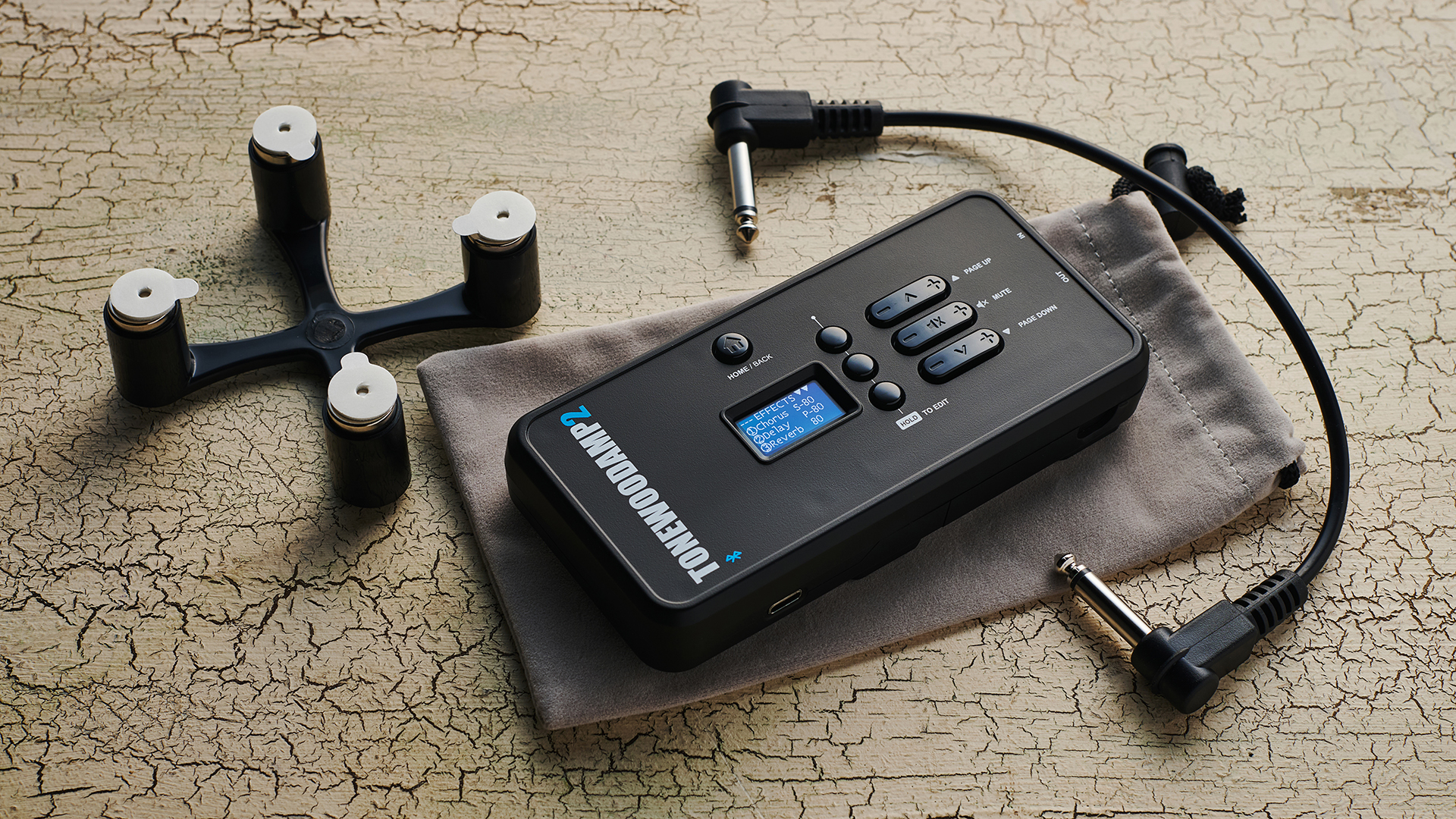
Build quality rating: ★★★★★
Side by side with the original ToneWoodAmp "Solo", the new model is obviously slimmer but it now places the small light-up digital menu screen on the front, rather than the side of the device. Before you still needed to check the front anyway to remind yourself of the various functions of the push rotary controls, so it's not a negative change. And the idea is you may well bypass the hardware controls to use the companion app anyway.
As it stands, the ToneWoodAmp2 is another rugged plastic build and the controls feel intuitively laid out. But you'll need to install the included "X-brace" into your guitar before you can find out that for yourself. It's not anywhere near as complicated as some might suspect. I chose to install it on my Auden Julia acoustic that is fitted with an aftermarket Takamine Tri-Ax soundhole pickup (essentially a licensed Baggs M1a model) and the only real complication was caused by that, not the brace.
I won't bore you with the details but it involves removing and reinstalling the pickup at a tricky angle to get access inside the soundhole to fit the brace. Sticking the brace inside the guitar, a couple of inches above the end and in middle of the back will be trickier on smaller soundhole guitars but for most users it won't be a challenge. However, you'll have to make sure you're not sticking it to your guitar's wooden bracing because that could negatively affect the vibrations. You also need to remove the strings first, of course.
The video above explains the process and how to do an initial test with your guitar, smartphone app and the ToneWoodAmp2 before even introducing the magnetic brace, but once it's on the device feels firmly fixed to the magnets, while still easy enough to remove when needed for charging.
Because of the way it's designed, a major plus of the ToneWoodAmp design is that you can fit it and get results whether you're using an aftermarket soundhole pickup or a stock piezo on your acoustic. And the new integrated LiftKit design now means curved back guitars aren't left out.
It's a clever design – simple and effective as I give it a try for size on my Taylor G-SMini with its slight arch back.
The whole ToneWoodAmp2 matches its slim but rugged build with satisfyingly clicky buttons. Smaller and with less text on the front than its predecessor, it also looks sleeker and more aesthetically pleasing… if anyone spends much time staring at the back of their acoustic guitar, that is.
If you're planning on it staying put there for a while, there are optional adhesive strips over the magnets on the unit. I'd think carefully before using them as the magnets feel secure enough to me, and the fact the company sells additional magnetic X-Braces means you can effectively use the ToneWoodAmp2 on multiple acoustics. Furthering the potential for acoustic-based live performers. It also comes with a pouch for when you want to keep it tucked away safely.
Usability
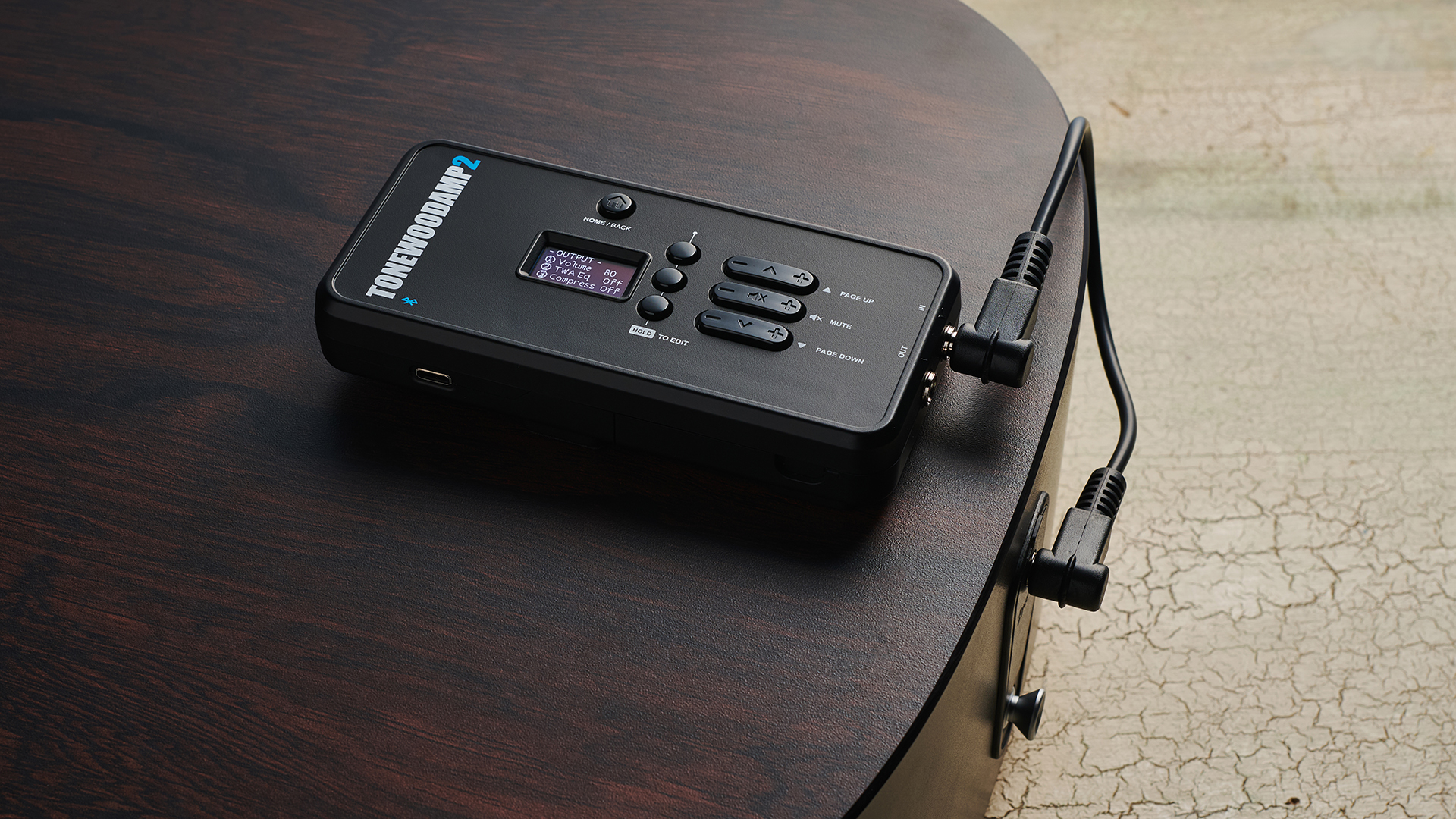
Usability rating: ★★★★★
The combination of having the choice between controlling the effects and activating compression on the hardware, and going much deeper on the app just works
I think it's safe to say ease of use if pretty vital for a wide range of musical gear, but when a company introduces an app to accompany a piece of hardware, the spotlight of expectation should be harder. Because if this extra access point doesn't improve the user experience, what's the point of it?
I've also tried enough gear where Bluetooth connectivity has been shaky to say the least on launch, so I approach the ToneWoodAmp's brand new app with trepidation. Great news then; it's brilliant.
The combination of having the choice between controlling the effects and activating compression and preset EQ on the hardware, and going much deeper on the app just works.
As I power things up and connect (quickly) via Bluetooth with my Samsung Galaxy Smartphone, it's not long before I can envision things onstage with the phone sat in a mic stand cradle. A tone station for my acoustic sounds right there.
Which is exactly what this is – Ofer and Helene have done the work, and it shows.
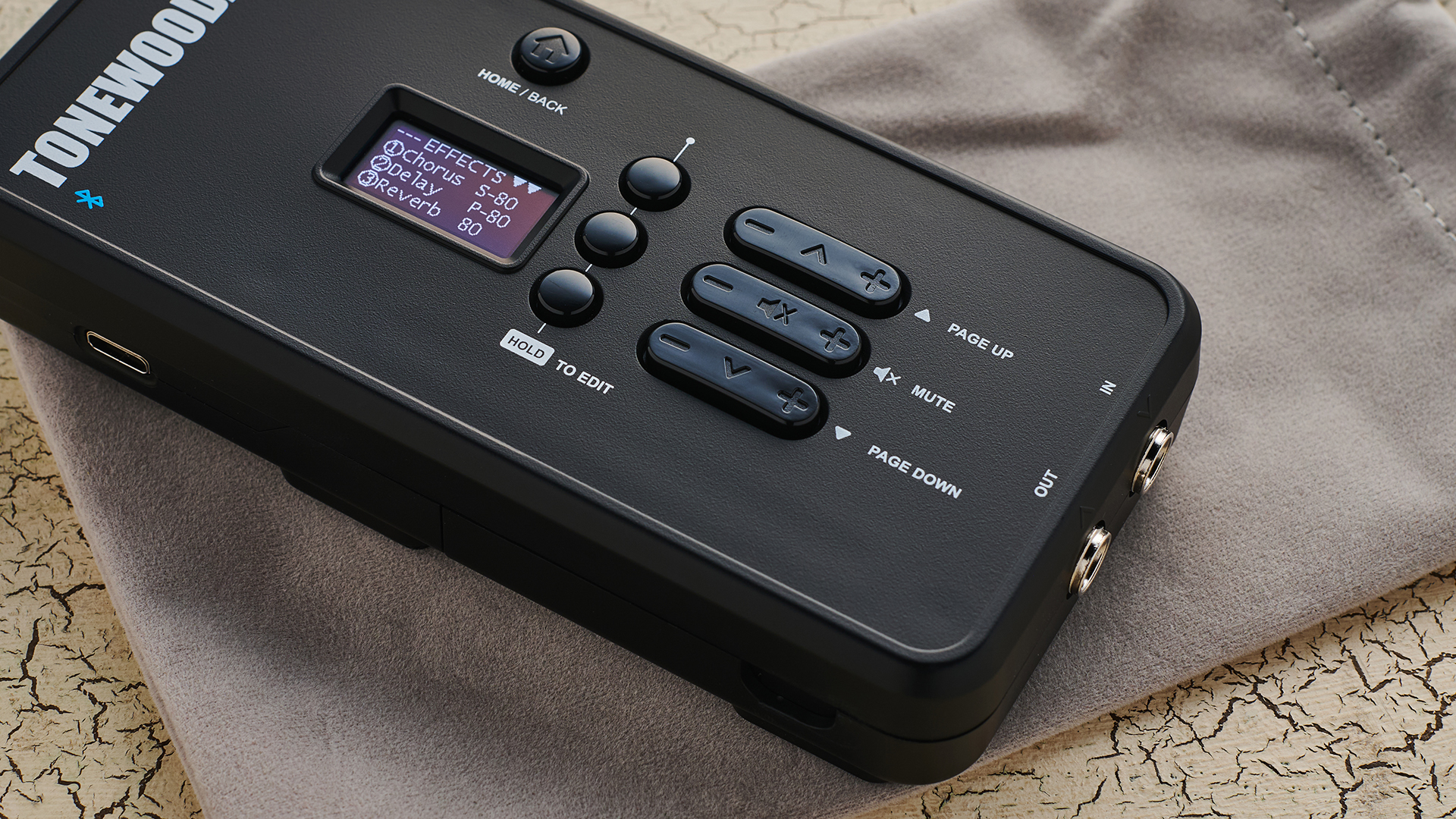
I think there are two distinct ways you can engage with the ToneWoodAmp2; you can have a lot of fun and creative inspiration simply exploring using the effects at home. But at the other end, you can utilise the extra features that have been included here, accessed via the new app, to really sculpt an acoustic sound for the stage that you love.
Because a lot of us acoustic musicians know that battle, right? It's a thankless task sometimes. The more control and flexibility you have when negotiating different venues with different acoustic guitars, the better. And that can apply to anyone turning up at an open mic. There's a potential here to really have the power to sound great at a gig, and make the changes needed to tweak that onstage quickly.
Helene and Ofer were kind enough to give me a run-through of the app on our call and I was surprised just how much there was to take in. But not in terms of complication – I think the menus and colourful layout really are intuitive enough to go into this cold – but just the amount of control options the ToneWoodAmp2 offers. And not just compared to its predecessor, but any aftermarket acoustic preamp anywhere near its price range.

The hardware controls will allow you to change on / off activation and levels for Reverb, Delay, Modulation and Tremolo (the modulation type and Tremolo are accessed via the page down button) and holding down each of the three effect buttons also enables speed and depth parameters for modulation (Flanger, Chorus, Phaser and Vibrato), time and repeat percentage for Delay, plus Reverb type and decay length. There's a handy mute switch too. All in all, an effective feature selection and controls for grab-and-go use without needing to reach for the app.
Activating the app reveals mini pedal icons representing those effects with tracks that can be slid on and off with corresponding levels, as well as the option to hear the sound of the effects in isolation. The other 'track' controls are for an FX dynamics level alongside Wet/Dry balance.
If you change effect settings, these will be saved when you shut the ToneWoodAmp2 off, which is a neat touch. You can effectively pick up from where you were if you only have time for a short playing session.
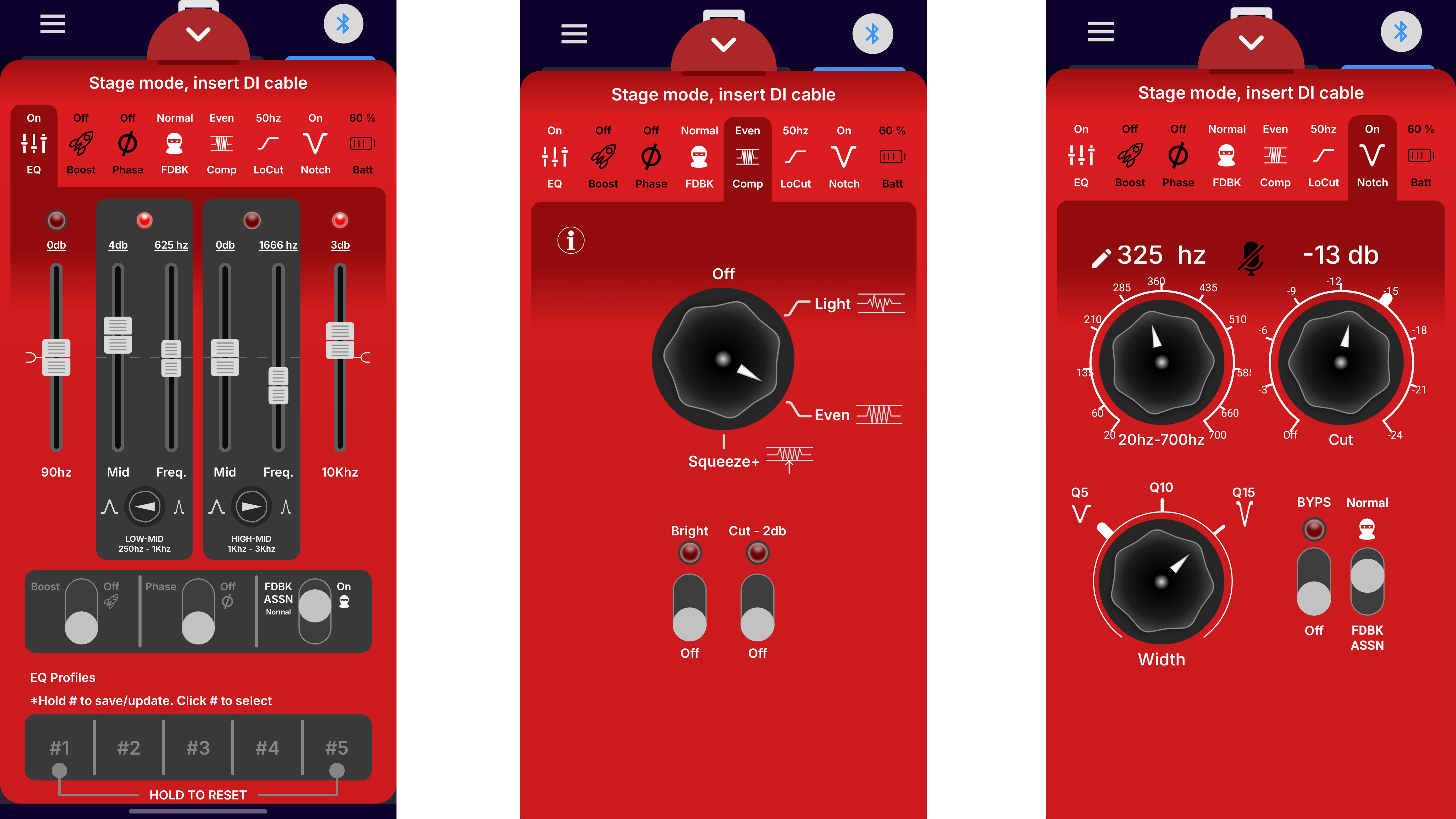
Players can also choose between series and parallel routing; passing through delay and reverb simultaneously in the latter but sequentially through modulation and delay in series. With different dynamics in play between them, it's worth experimenting to find your preferences.
The deeper part is accessed via the input settings and when you plug into the output of the ToneWoodAmp and activate Stage Mode. This where it becomes very clear there's a lot more here for live players.
"We designed the first one ten years ago and since then there are different ways people interact with the device," Ofer tells me. "The ability to do more and do it with an app was something we wanted to add. When we were talking about taking it to the stage we just knew that with this new architecture, we'd have the ability to do it."
The app is extra helpful in offering information tags that explain the function of some of these features – and Ofer says there will be ongoing support to add even more.
Stage Mode offers a wealth of further options
Things like the Feedback Assassin (automatic notch filters for quick feedback reduction), Low Frequency Limiter to prevent unruly bass notes and individual Notch Filters (over six freqencies) are all there to help mix out unwanted sounds onstage, with a Master Gain to get your levels in check and avoid the wrath of the sound engineer. The ability to quickly access saved profiles for different acoustic instruments is also handy – you can have completely different EQ and effects setups for songs or specific guitars.
Stage Mode offers a wealth of further options; they are presented clearly but live players will need to take time to try things out at stage volumes to get confident with control. You'll have five presets once you dial in your preferences for using the four-band parametric EQ and low and high mid levels that are crucial in my experience when mixing into an ensemble where drums are involved.
Compression here is tailored for DI use with your acoustic, and can even out or focus your pick or finger attack with Light, Even and Squeeze presets, while a Low Cut Filter can cut at 40, 85 and 110Hz. There's separate compression for the effects too.
It's a lot of control in a very small package and reminds me of an advanced version of my trusty Laney A1 combo amp from my acoustic band gigging days. But pocket-sized.
In my extensive time with the new app I expected to find glitches, crashes and bugs, but this software has clearly been tested thoroughly and it was honestly a joy to use. But how does it all sound?
Sounds
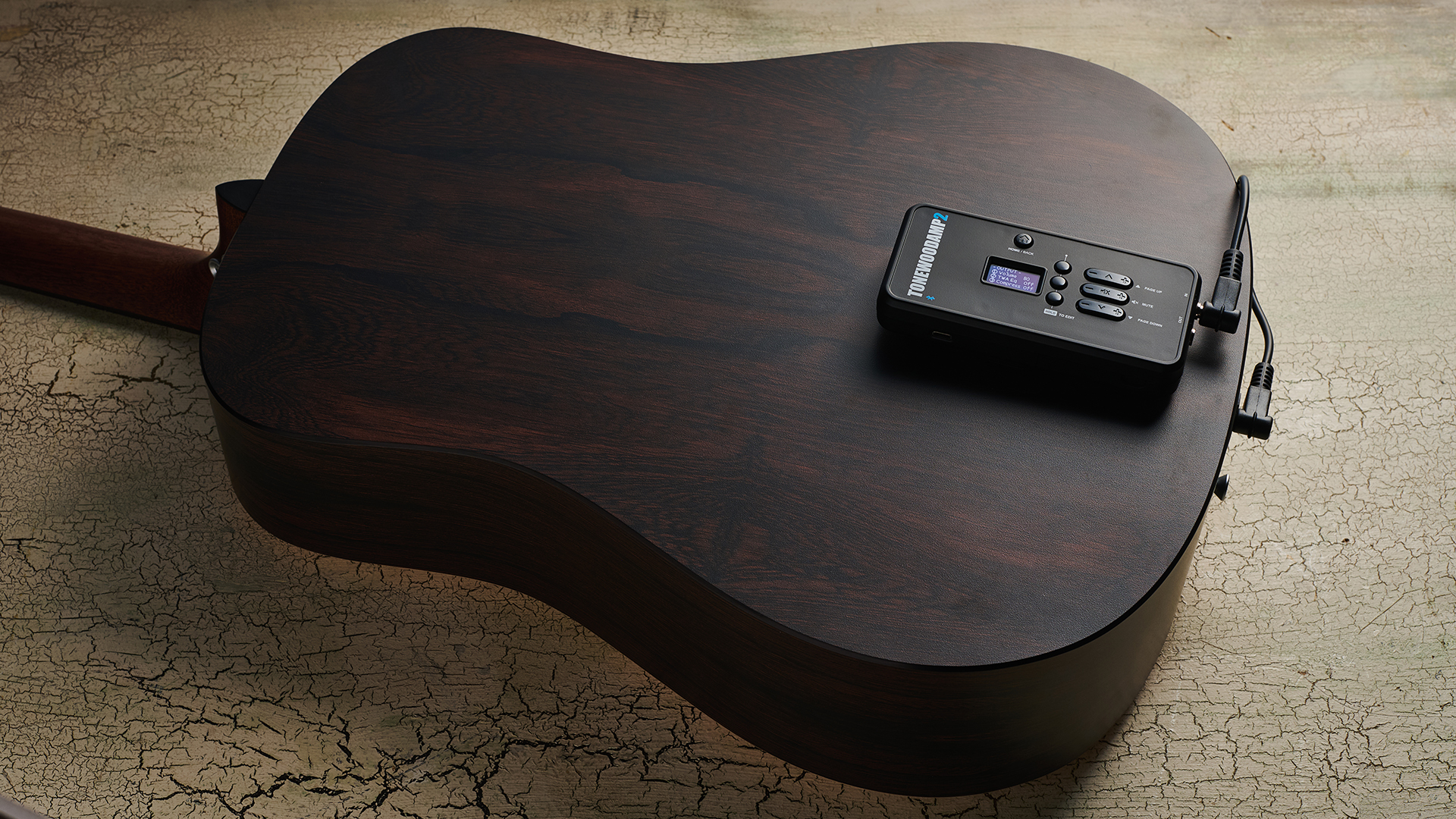
Sounds rating: ★★★★★
The ToneWoodAmp doesn't have direct competition as a device with a similar feature set that can be fitted to an electro-acoustic guitar of your choice, but I've tried the most popular acoustic guitars that have inbuilt effect-generating technology, and I think this clearly has the edge on the range and quality of the effects alone. The fact you can run four effects at once here makes the potential even wider.
The delay blends well with the acoustic voice while sounding distinct, the choice of reverbs sound organic. The modulation selection and tremolo work very well here for textures without sounding gimmicky. These all feel tailored to the acoustic and I tried them with both a solid mahogany Sigma dreadnought with entry-level Fishman Sonitone preamp, plus my smaller-bodied Auden Julia with an active soundhole pickup.
You'll really notice it most when you play with the ToneWoodAmp turned off and wonder if you'll ever play without it again
The latter is three times the price of the Sigma, and I did find it more resonant with the ToneWoodAmp2, perhaps because it's also reflecting some of the qualities of the guitar it's fitted to, but also the soundhole pickup I use picks up the guitar's vibrations. But it was still impressive with the same Sigma I tested the original ToneWoodAmp on years ago, giving it a new lease of life.
You can go silly with the decay levels on the reverb, but when used subtly, it enhances everything, especially leads and arpeggios. You'll really notice it most when you play with the ToneWoodAmp turned off and wonder if you'll ever play without it again.
Compared to the original ToneWoodAmp we gain Flanger, Phaser and Vibrato here, but lose overdrive, auto-wah and Leslie-style tremolo. A good trade – I don't miss them. The deeper EQ control feels like a much better deal too. Without exploring that side and sticking to the unit's onboard controls and effects only, I found the switch to buttons from rotary controls much more intuitive compared to the first ToneWoodAmp. Turning effects on or off, and even changing delay time was painless. If you want tap-tempo you'll need the app but it's great to find how much control is still available on the hardware.
For players at home – especially songwriters – these sounds are so inspiring. It's important to spend the first few minutes getting your guitar's preamp level dialled in with the ToneWoodAmp's levels to avoid unwanted feedback, especially from open strings, but I actually found this iteration quicker to set up than the first one.
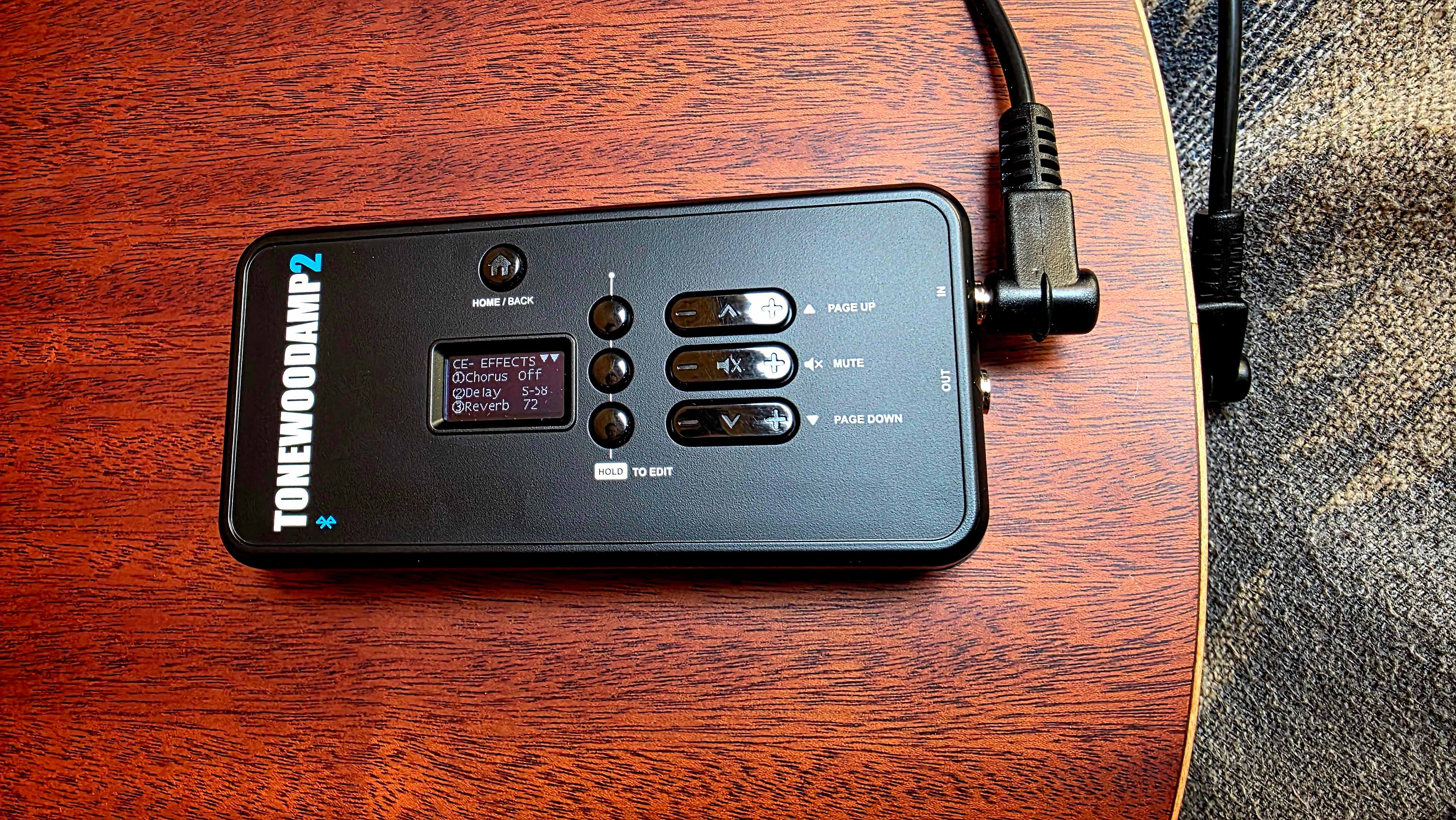
This very quickly feels like a powerful preamp and pedalboard at my fingertips
Plugging into my Line 6 Power Cab set to flat mode, I'm able to hear what the ToneWoodAmp2 can offer at stage levels. The effects on the piezo-loaded Sigma sound much more direct and upfront at the same levels I set for the Auden (unsurprisingly considering the nature of a piezo) so I dial things down on the wet/dry mix.
The Sonitone can often sound brittle, compressed and 'quacky' like a lot of piezos when DI'd but the four-band EQ is hugely effective in shaping these out and getting the best from the piezo, with some light compression and plate reverb giving me a stage-ready foundational sound I'd be very pleased to gig with.
The ToneWoodAmp2's EQ also allows me to carve a less steely sound for the airier character of my Auden's aftermarket soundhole pickup too, until I get something that's much more rounded and mellow for strumming.
This very quickly feels like a powerful preamp and pedalboard at my fingertips, and I begin to set up potential presets that build on my EQ preferences - adding some light tremolo for a little extra movement in chordwork (a Steven Wilson tip I picked up) and a different compression setting suited to a fingerstyle piece. Making these changes soon becomes second nature and reveals a device that has taken on new levels of potential in its latest iteration.
Verdict
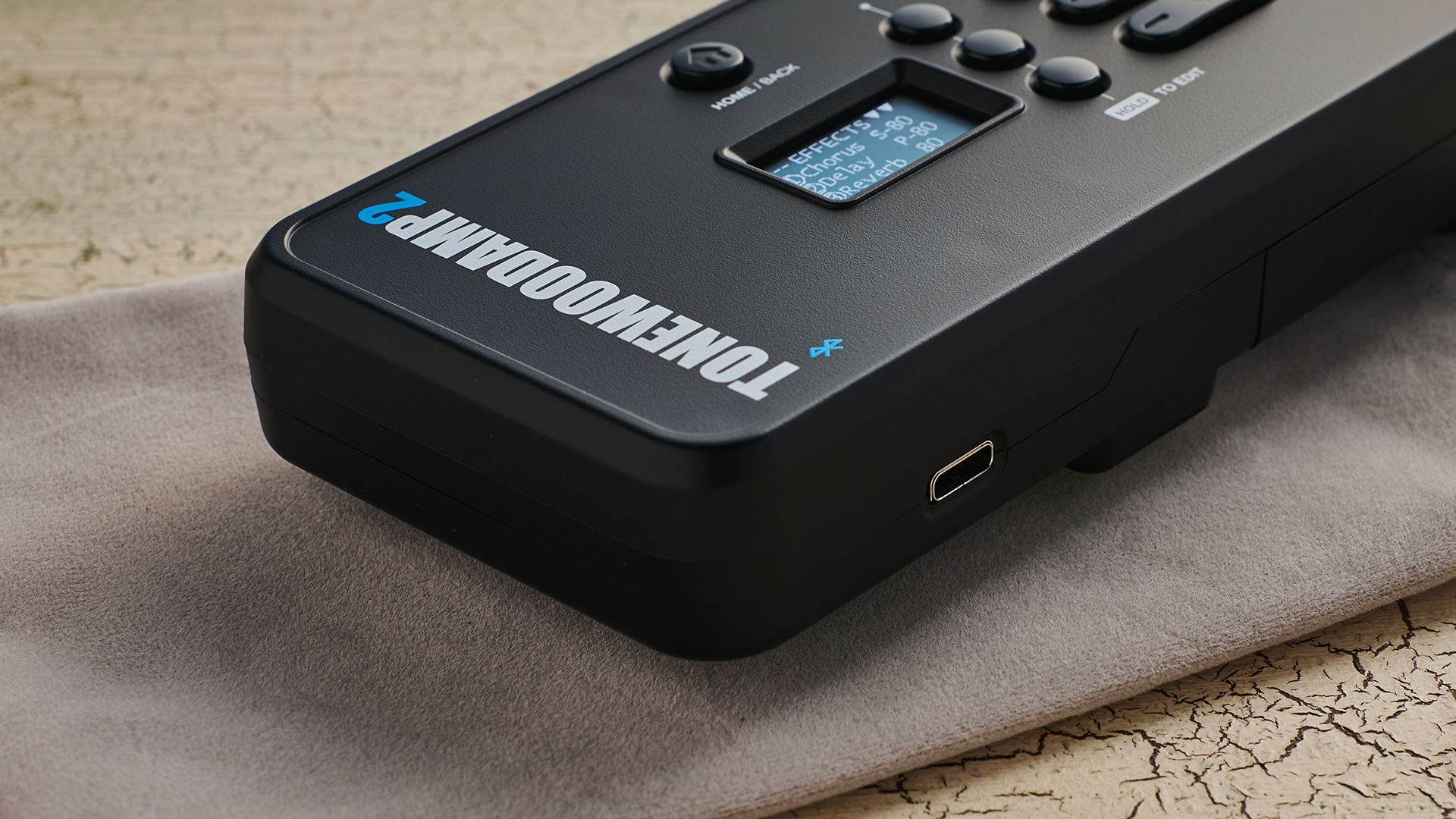
I've picked up my acoustic far more since I've been testing the ToneWoodAmp2 because it just sounds so good and is so easy to use
If you're looking for something to add extra effects and control over your sound live in a compact package, I think the ToneWoodAmp2 represents a great investment. It could become your new best friend as an acoustic player onstage.
For the home hobby player and songwriter it's less essential utility and more inspiring luxury – but I wouldn't dare discount the importance of that. We all want things that make us want to play, and sound better. I've picked up my acoustic far more since I've been testing the ToneWoodAmp2 because it just sounds so good and is so easy to use. It's too easy for acoustics to be left out of the effects world party, but this is tailor-made for them to dive in and enjoy it, with added flexibility.
The rechargeable battery and its additional life here is probably the greatest real-world upgrade over the first ToneWoodAmp. It easily delivered on the 10+ hours life the company states in my testing, and I was actually surprised I still had 50% after what seemed like a lot of playing and tinkering.
Another pleasant surprise is just how much I wanted to use the app – something I have been sceptical about as a growing trend in guitar hardware evolution elsewhere (pedal market, I'm looking at you). But it makes perfect sense here in offering a deeper experience for players, and effecitive control for the stage. It contributes to making this feel like a significant upgrade in every respect, and a frontrunner as one of my favourite guitar gear releases in recent years.
Guitar World verdict: Everything a sequel should be. Inspiring effects you won't want to play without, easy to use in every respect and deep preamp controls for live players.
Test | Results | Score |
|---|---|---|
Build quality | Robust build and straightforward to install yourself. | ★★★★★ |
Usability | A lesson in how hardware and app control can co-exist and thrive. | ★★★★★ |
Sounds | Excellent additions on the modulation side and best in class when it comes to this kind of acoustic guitar effect generation. | ★★★★★ |
Overall | Great effects, much improved on the battery side, but a huge leap in terms of a stage preamp tools too. | ★★★★★ |
Hands-on videos
ToneWoodAmp with JB Eckl

Rob has 20 years of experience writing, reviewing, interviewing and editing for guitar magazines and websites, including Guitarist and Total Guitar.
Over the years he's interviewed artists including Metallica, Black Sabbath, Pearl Jam and Soundgarden, but he's lost count of all the guitar gear he's tested.
He's now Reviews Editor for GuitarWorld.com, Guitar World magazine and MusicRadar guitars, heading up our in-house reviews team to give you in-depth and honest tests of the latest guitar gear. He eats and dreams reviews.
You must confirm your public display name before commenting
Please logout and then login again, you will then be prompted to enter your display name.




